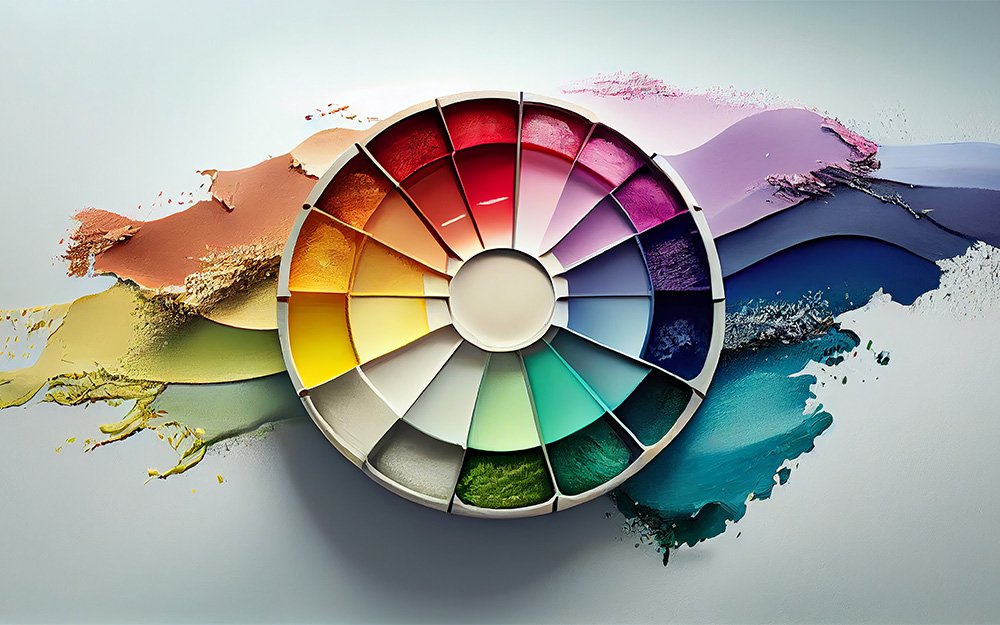Color, with its enchanting power to evoke emotions, set moods, and capture attention, is a cornerstone of graphic design. Whether on a website, in a print ad, or within a logo, color is a language that speaks to the viewer, conveying messages that transcend words. In this exploration of the art of color theory in graphic design, we delve into the fascinating world of hues, shades, and tones, understanding how designers harness the magic of color to create impactful visual experiences.
The Color Wheel: A Designer’s Compass
At the heart of color theory lies the color wheel, a fundamental tool that guides designers in their creative endeavors. Comprising primary, secondary, and tertiary colors, the wheel provides a systematic approach to color harmony and contrast. [1]
- Primary Colors: Red, blue, and yellow form the base of the color wheel, as they cannot be created by mixing other colors.
- Secondary Colors: By blending primary colors, we obtain secondary colors: green, orange, and purple.
- Tertiary Colors: Further mixing secondary and primary colors yields tertiary colors, expanding the palette’s range.
Color Harmony: Striking the Right Chord
Creating pleasing visual compositions often relies on achieving color harmony. Designers employ various color schemes to establish balance and cohesion within their work. These schemes include:
- Analogous Colors: Colors adjacent to each other on the color wheel create harmony and a sense of flow.
- Complementary Colors: Pairs of colors located directly across from each other on the wheel provide striking contrast.
- Triadic Colors: Three equidistant colors on the wheel form balanced triads, offering both contrast and harmony.
- Monochromatic Colors: Variations in the intensity and value of a single color create a sophisticated, unified look. [2]
The Psychology of Color: Crafting Emotional Connections
Color transcends aesthetics; it elicits emotions and influences behavior. Understanding the psychology of color empowers designers to create content that resonates with the target audience.
- Red: Evokes passion, energy, and urgency. Commonly used in calls to action.
- Blue: Conveys trust, calmness, and reliability. Frequently seen in corporate branding.
- Yellow: Radiates optimism, warmth, and friendliness. Often associated with creativity.
- Green: Symbolizes nature, growth, and health. Prominent in environmental initiatives.
- Purple: Represents luxury, creativity, and sophistication. Often used in high-end brands.
- Orange: Exudes enthusiasm, youthfulness, and energy. Engages attention effectively. [3]
Color in Branding: The Visual Identity
In branding, color serves as a potent tool for brand recognition and storytelling. Memorable logos often feature carefully selected colors that align with the brand’s values and message. For instance, the red of Coca-Cola exudes excitement, while the blue of Facebook exudes trust.
The Digital Canvas: Color in Web Design
In the digital age, web designers harness color to create intuitive and visually pleasing user interfaces. Websites use color to guide users, establish hierarchy, and evoke desired emotions. Ensuring accessibility by considering color contrast ratios is also crucial for inclusive web design. [4]
In the realm of graphic design, mastering the art of color theory is akin to wielding a painter’s brush. It empowers designers to convey messages, evoke emotions, and captivate audiences through the strategic use of color. As technology advances and design trends evolve, the principles of color theory remain a timeless foundation, guiding designers in their quest to create compelling visual experiences.
Disclaimer: The views and opinions expressed in this article are those of the author and do not necessarily reflect the official policy or position of Dexines or any other organization. The information provided in this article is for general informational purposes only and should not be construed as professional advice. Dexines makes no representations or warranties of any kind, express or implied, regarding the accuracy, adequacy, validity, reliability, availability, or completeness of any information in this article. It is advisable to consult with a qualified professional or seek appropriate guidance before making any decisions or taking any actions based on the information in this article.
